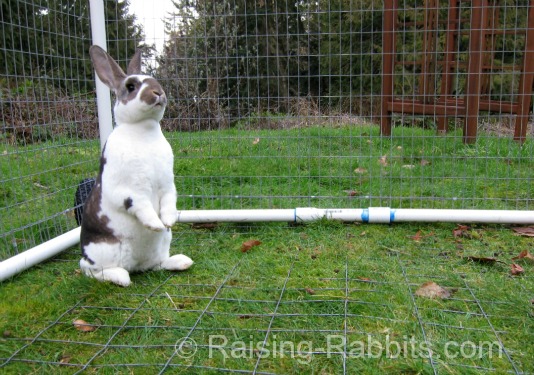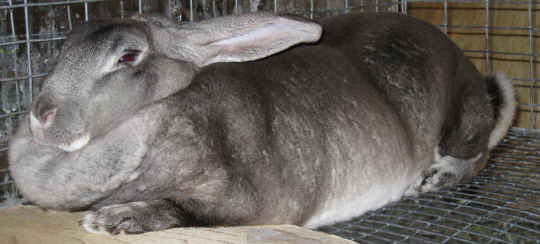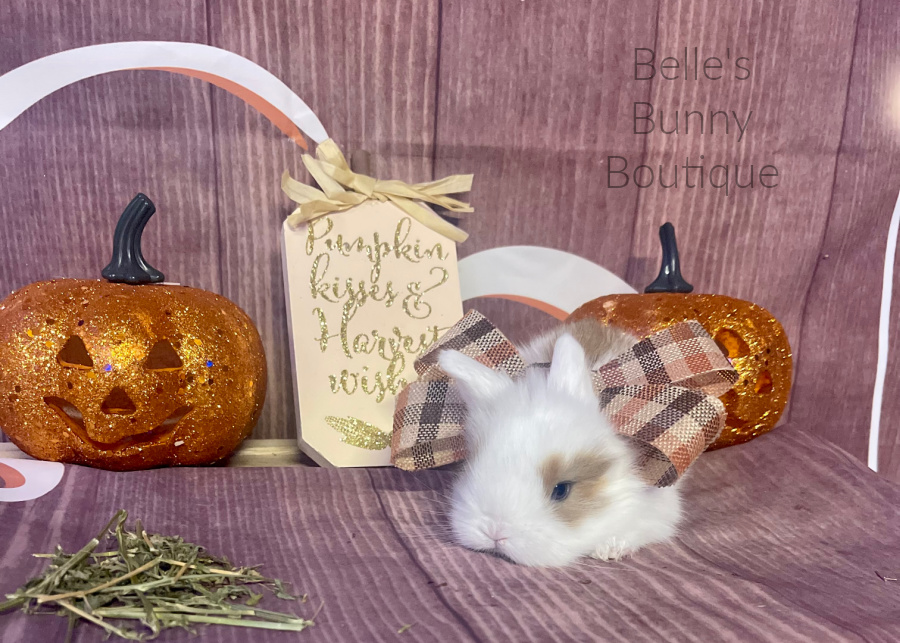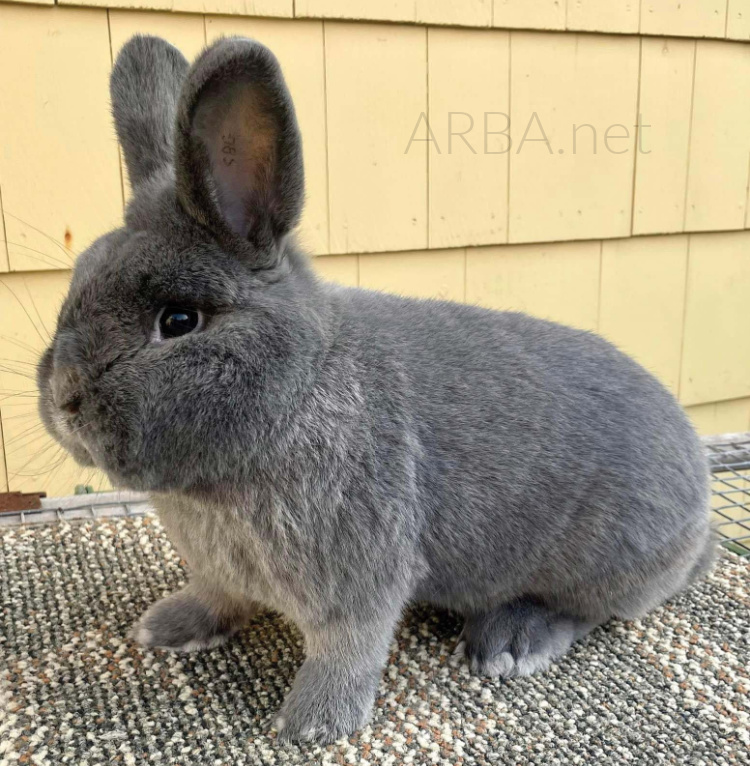Rabbit Facts
Rabbit Facts: Interesting facts about rabbit
brains, their instincts, how they think, fear vs pain. Here are facts about rabbits that
shed light on contentment in rabbits.
Rabbits in the Wild
Take a peak into the first few months in the life of a wild rabbit.
- The rabbit doe gives birth to 3-5 kits in the wild. They are born in a fur- and grass-lined burrow that she dug a few days before birth.
- A day later, her mate-for-life and the sire of her bunnies meets her around dusk. They are foraging at the edge of a clearing. They mate again.
- For the next three-and-a-half weeks, she eats,
sleeps, and feeds her babies. At around 2 or 2.5 weeks old, the kits stumble
out of the nest into the waning sunshine for the first time.
- Over the next week and a half, their dam will
give them a crash course in watching for hawks and cats, how to thump if they
sense danger, and how to press themselves frozen into the grass when the shadow
of an eagle passes overhead. They might have time to bolt for the burrow.
- They receive about 1.5 weeks of survival skills, because
her belly is swelling. When her current kits are 27-28 days old, they’re
on their own, abandoned by the doe. She has just three days to locate and dig a
new burrow for the new, soon-to-be-born litter.
- Before the 5 kits are three months old, 1 kit has
died before weaning. 3 kits have fallen prey to hawks, ferrets or foxes, and 1 kit still survives. Every day that passes increases the likelihood he’ll
survive to adulthood.
- All is well. The fallen rabbit kits have served
the purpose for which the species was intended: to be prey for nearly every
predator species. One or two will survive to produce more kits so the species will
continue and predators will eat another day.
Rabbit Raising Problem Solver, Available on Amazon.com or through Raising-Rabbits.com
How Rabbits think:
Rabbit Facts about Pain vs Anxiety
Speaking of predation, let's consider the rabbit facts regarding the relationship between predator and prey.
- Does
predation result in the domination of rabbits by bobcats, hawks and coyotes?
- Is
it cruel that rabbits are naturally destined, as a primary prey animal, to
untold pain and horror, and to untimely and excruciating death?
No, and no, which requires rethinking this 'pain' thing.
According to animal behavioral expert, Dr. Temple Grandin*, in her book, Animals in Translation, prey animals (such as rabbits) have very underdeveloped or even nonexistent pain-sensing regions in their brains (ch.5). At the same time, rabbits instinctively know that everything out there wants to eat them. This awareness is part of their genetic code, resulting in their timidity and high alert (anxiety) levels. Rabbits are highly attuned to the possibility of threats in their environment.
Every rustle of the grass, uncertain sound or whisper of raptor wings shoots a rabbit’s anxiety level sky high. In fact, animals, especially prey animals, are far more terrified of anxiety and stress than they are of pain, according to Dr. Grandin.
If this doesn’t seem logical, we understand. We humans easily put up with high stress levels, aggravation and anxiety, at least for short stretches. But the thought of bodily pain wilts the best of us. Talk about cancer, and we go pale around the gills - terrified of the excruciating agony that often occurs in end-stage cancer.
Dr. Temple Grandin: Voice of wisdom when it comes to animals:
~~~~~~~~~~~~~~~
*Dr. Temple Grandin is a brilliant scientist who has peered into animal minds to help the rest of us understand them better.
~~~~~~~~~~~~~~~
 This rabbit is in a very large, open-to-the-air rabbit run. It is anxious enough to remain very much on alert.
This rabbit is in a very large, open-to-the-air rabbit run. It is anxious enough to remain very much on alert.Rabbits are very different from humans.
Even as a predator rends a rabbit limb from limb, the rabbit may not feel much pain at all, at least, not in the manner that we humans sense it. The idea that rabbits experience 'untold pain and agony' during predation, or even during butchering by humans, is not supported by science.
While prey animals are no doubt capable of feeling pain, it is the anxiety and fear that keeps the rabbit alive in dangerous situations. Problem is, beyond a certain threshold of fear, terror can literally paralyze a rabbit, completely incapacitating it. A rabbit’s high-pitched scream is a response to terror , whether logical or not, not pain.
Young 2.5-week-old rabbits have occasionally screamed in terror in my hands, as a response to being gently and painlessly picked up for petting and socialization. Their fear got the best of them. They learned quickly, however, that being picked up was a good and gentle and welcome occurrence.
Sherwood Forest Feeds: The best there is on the market, currently.
Adult rabbit feeds available in 4.5 lb and 10 lb bags.
Happy Rabbits:
Rabbit Facts about Rabbit Emotions
 Chinchilla Rex Rabbit Doe
Chinchilla Rex Rabbit DoeWhen you see caged domestic rabbits all stretched out comfy-like and relaxed in their cages, it is because their anxiety levels are hovering somewhere near zero. They’re content, relaxed. Many domestic rabbits, from a thousand generations until now, have known nothing but cages, runs and larger runs (sometimes called colonies).
Rabbits don’t think like people and don’t feel like people.
It is wise therefore to not "anthropomorphize," or assume a caged rabbit is miserable because you would be miserable in a cage. In their cages, there are no eagles screeching overhead, no coyotes chasing their back trails or ripping hungrily at their heels. In their cages, they get food and water delivered directly to their doors by a keeper that speaks softly, scratches their ears and rubs their fur.
If caring for pet rabbits means they’re stress-free and have all their physical
needs met, the rabbit facts studied by animal experts indicate that your pet rabbits will be truly content.
Go from Rabbit Facts to Facts About Rabbits as Pets
Double-Value Guarantee
Our policy is to always OVER-deliver
on value,
which is why your purchase is fully covered by our
Double-Value
Guarantee.
Go ahead - take any of our e-books for a test drive. Peruse our detailed informational and educational e-books. Examine our plans for building rabbit cages, runs, or metal or PVC hutch frames. Check out the Rabbit Husbandry info e-books.
If you aren't completely satisfied that your e-book purchase is worth at least double, triple or even quadruple the price you paid, just drop us a note within 45 days, and we'll refund you the entire cost. That's our Double-Value Guarantee.
Note: When you purchase your
e-books, they will be in PDF format, so you can download them to any device that
supports PDF format. We advise making a back-up copy to a drive or cloud
account. If the books are lost, you can also purchase another copy from Raising-Rabbits.









New! Comments
Have your say about what you just read! Leave me a comment in the box below.